

Winter solstice. Winter solstice in Northern Hemisphere over Asia.
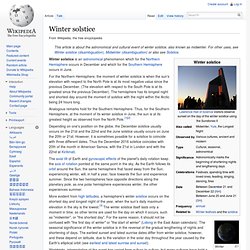
Winter solstice is an astronomical phenomenon which for the Northern Hemisphere occurs in December and which for the Southern Hemisphere occurs in June. Imbolc. Imbolc is mentioned in some of the earliest Irish literature and there is evidence it has been an important date since ancient times.
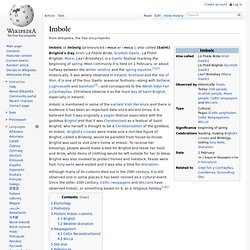
It is believed that it was originally a pagan festival associated with the goddess Brighid and that it was Christianized as a festival of Saint Brighid, who herself is thought to be a Christianization of the goddess. At Imbolc, Brighid's crosses were made and a doll-like figure of Brighid, called a Brídeóg, would be paraded from house-to-house. Brighid was said to visit one's home at Imbolc. To receive her blessings, people would make a bed for Brighid and leave her food and drink, while items of clothing would be left outside for her to bless. Brighid was also invoked to protect homes and livestock. Although many of its customs died out in the 20th century, it is still observed and in some places it has been revived as a cultural event. Etymology[edit] Battle of Barry. Coordinates: Account of battle[edit] The account of the battle was first recorded by sixteenth century Scots historian, Hector Boece.[4] According to the legendary account, the army camped at St Abb's Head for several days before sailing north, landing at Lunan Bay in Angus.
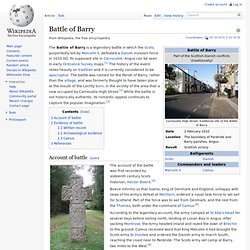
After sacking Montrose, the Army headed inland and razed the town of Brechin to the ground. Camus received word that King Malcolm II had brought the Scots army to Dundee and ordered the Danish army to march South, reaching the coast near to Panbride. The two sides met and fought in the vicinity of the Lochty Burn, near where Carnoustie town centre now lies. Seeing that the battle was lost, Camus fled to the hills, pursued by Robert de Keith (purported ancestor of the Marischals of Scotland), who caught up with and slew him at Brae Downie where, it is said, the Camus Cross (NO 519379) was erected in memory of him.[5][6] Evidence of battle[edit] Written record[edit] Archaeological evidence[edit] Beltane. Lughnasadh. Lughnasadh or Lughnasa (pronounced LOO-nə-sə; Irish: Lúnasa; Scottish Gaelic: Lùnastal; Manx: Luanistyn) is a Gaelic festival marking the beginning of the harvest season that was historically observed throughout Ireland, Scotland and the Isle of Man.
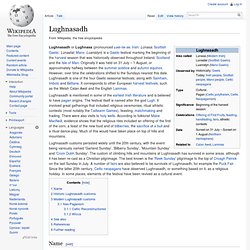
Originally it was held on 31 July – 1 August, or approximately halfway between the summer solstice and autumn equinox. However, over time the celebrations shifted to the Sundays nearest this date. Lughnasadh is one of the four Gaelic seasonal festivals; along with Samhain, Imbolc and Beltane. It corresponds to other European harvest festivals, such as the Welsh Calan Awst and the English Lammas. Lughnasadh is mentioned in some of the earliest Irish literature and is believed to have pagan origins. Lughnasadh customs persisted widely until the 20th century, with the event being variously named 'Garland Sunday', 'Bilberry Sunday', 'Mountain Sunday' and 'Crom Dubh Sunday'. Name[edit] Historic Lughnasadh customs[edit] Neo-Paganism[edit]
Industrial Revolution. Iron and Coal, 1855–60, by William Bell Scott illustrates the central place of coal and iron working in the industrial revolution and the heavy engineering projects they made possible.
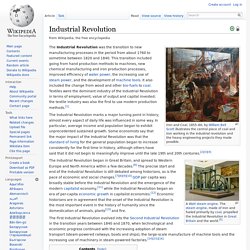
The Industrial Revolution was the transition to new manufacturing processes in the period from about 1760 to sometime between 1820 and 1840. This transition included going from hand production methods to machines, new chemical manufacturing and iron production processes, improved efficiency of water power, the increasing use of steam power, and the development of machine tools. It also included the change from wood and other bio-fuels to coal. Samhain. Samhain (pronounced /ˈsɑːwɪn/ SAH-win or /ˈsaʊ.ɪn/ SOW-in)[1] is a Gaelic festival marking the end of the harvest season and the beginning of winter or the "darker half" of the year.
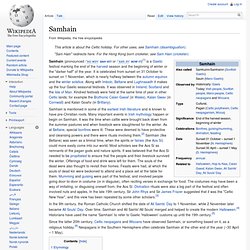
It is celebrated from sunset on 31 October to sunset on 1 November, which is nearly halfway between the autumn equinox and the winter solstice. Along with Imbolc, Beltane and Lughnasadh it makes up the four Gaelic seasonal festivals. It was observed in Ireland, Scotland and the Isle of Man. Kindred festivals were held at the same time of year in other Celtic lands; for example the Brythonic Calan Gaeaf (in Wales), Kalan Gwav (in Cornwall) and Kalan Goañv (in Brittany).